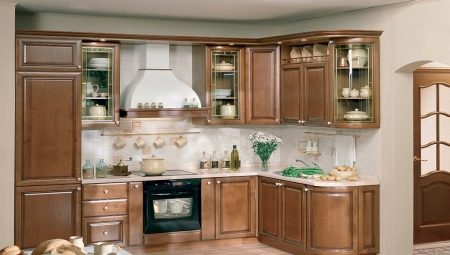A corner cupboard is a popular piece of furniture that occupies hard-to-reach or unused space. They are assembled from different materials, come in different styles, which makes it possible to choose the best option for any size of the kitchen. Such cabinets can be of different types, sizes, they can be selected for every taste.
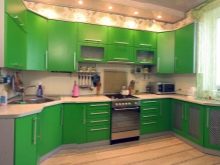

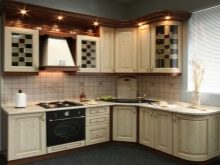
Benefits
The advantages of using corner cabinets in the kitchen are enough:
- the useful area of the room increases;
- good roominess, multifunctionality;
- the dimensions of the furniture are different, so you can easily create an individual design;
- the facade can be decorated in various ways, for example, decor or glass;
- the kitchen set includes cabinets, some have a hinged view, while others have a floor;
- similar designs look beautiful, harmonious and stylish.
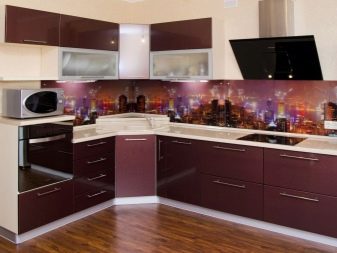
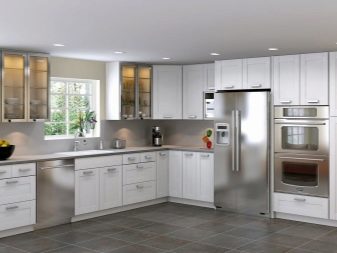
Size range
Consider the dimensions of the kitchen corner cabinets. After all, each option has its own size. Designs come in different forms: mounted, floor, under the sink. They blend well with the overall style of the room. The corner cabinet can have non-standard dimensions.

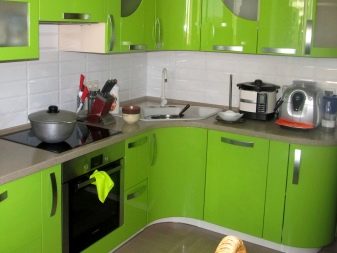
Before buying a corner headset, you need to determine the size, quantity, shape of the shelves, as well as the distance between them.
In order to place heavy utensils, the height of the shelves should be from 22 cm, for small items - from 19 cm.
Individual planning can be done according to the drawings in a room with any size. You need to know the exact size of the kitchen, the location of the modules, design, individual preferences of the owner of the apartment. Below we will examine in detail the dimensions of corner cabinets.
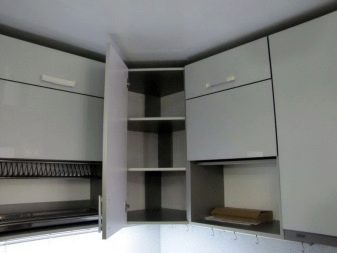
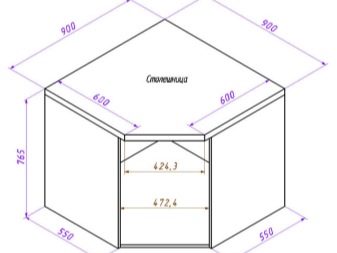
Lower corners
In most cases, the lower corners are both straight (90 degree joint) and trapezoidal (45 degree joint).
90 degrees
The structure is formed at the junction of two boxes, the base is a common horizon. The depth of the countertops that are at the junction with each other can be different. Worktops are well joined with a depth of 600x420 mm, 600x600 mm.
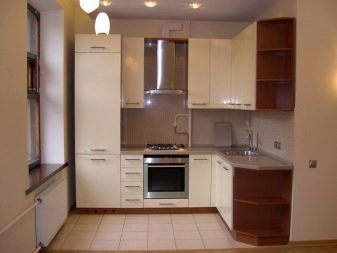
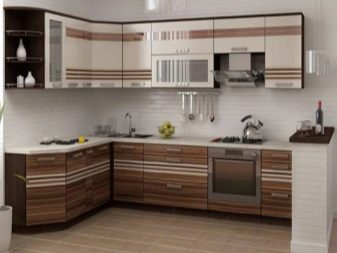
If we consider the option with a tabletop depth of standard sizes 600x600 mm, the dimensions of the angle determine the dimensions of the parts in the neighborhood. If the depth is 460 mm, then the distance to the wall should be 100 mm. If the facades are wider than 400 mm, then the dimensions of the angle will be equal: 100 + 460 + 400 = 960 mm. The dimensions of the boxes will be 860 mm.
This is the most primitive calculation, which does not take into account the thickness of a blank wall, for example.
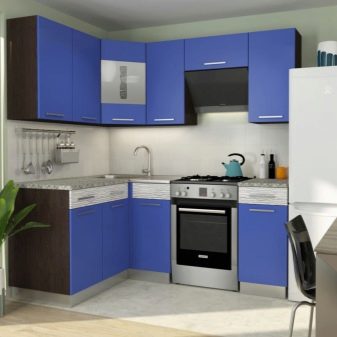

Trapezoid
They contain straight and radius facades. Their sizes depend on the facades and the depth of the countertops.
The most common version of the box, countertops, facade, their width is 400 mm. Dimensions from corner to module are 840 mm. The module itself is 740 mm. This is quite a roomy and optimal option. A drawer, as well as an oven, will successfully enter into such a corner.
However, with this arrangement, part of the space of the room will not be used.
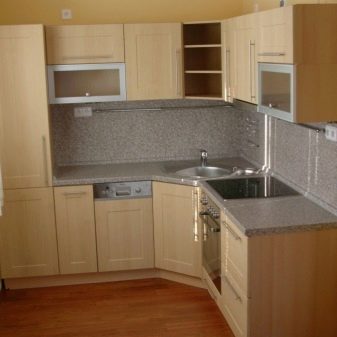

Top corners
All the same as the lower corners. However, they fit snugly against the wall of the room. The facades are arranged accordion, if the joint is 90 degrees, if the module is trapezoidal, then the facades are radius.
- Upper trapezoidal angle (45 degrees). If the width of the facades is 400 mm, then the depth will be 300 mm.
- Top joint 90 degrees. The same characteristics as in the above embodiment will result in a size of 700 mm.
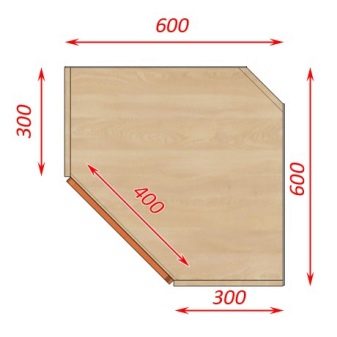
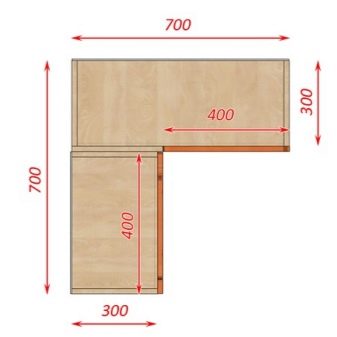
It should be noted that the examples presented are not drawings, because they do not have exact dimensions. These are sketches showing approximate dimensions of the kitchen corners. However, a quick calculation allows you to approximately determine the size of the modules for the kitchen set. In addition, this is only one of many options.
It should be noted that the dimensions of the facades may vary, and the modules may consist of one or more facades. Naturally, the sizes will change, another calculation will be needed.

Drawings of the upper and lower corner cabinets
Consider the drawings of various designs for the kitchen.
Curved facades and between them a corner with cabinets
The kitchen set looks advantageous, in which the corner comes with rounded cabinets. This makes it possible to comfortably wash the dishes and use the sink. This streamlined shape looks good if there are cabinets with curved doors on one wall.

The set will fit well into the following room sizes: wall length 2420x1750 mm. This design has cabinets with curved facades:
- 900x900 mm - floor corner;
- 600x600 mm - hinged angle;
- 320 mm, if the product with curved doors;
- 600 mm - a place for hoods and built-in appliances.
The size is conditional, since in a large kitchen you can install a range hood and hob, each up to 90 cm wide. The size of the product with a curved facade depends on the radius of the door. If you change the width of the cabinet, then the facade will decrease or increase.
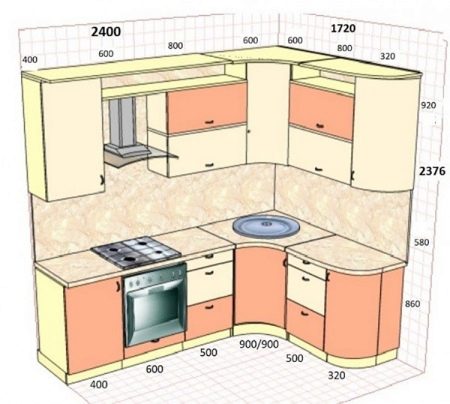
If you change the size from 900x900 mm to 700x700 mm, then you need to keep the standard tabletop depth of about 600 mm. The radius of the door is small, so access to the cabinet itself will be significantly limited.
The same applies to a wall cabinet with a concave type door. The depth will be 300 mm, the radius of the facade will be standard sizes, and the width of the cabinet - 600x600 mm.
The dimensions of the remaining products can be increased, reduced to adapt to the general scheme of the headset.
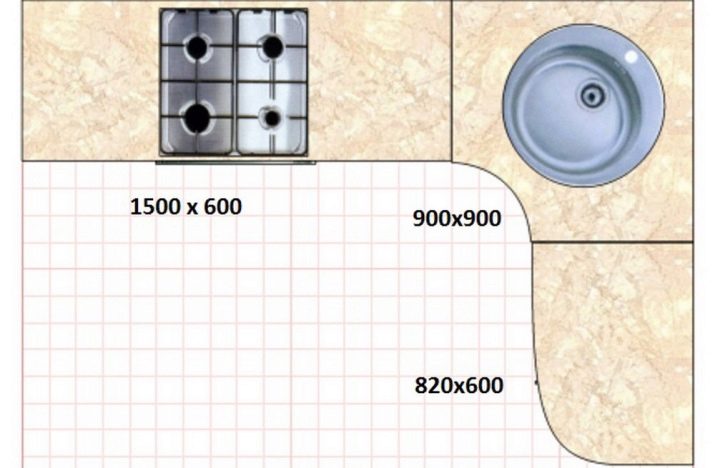
Corner with straight facades
The calculation is similar to the markup, as for a headset with a corner kitchen and a concave corner. Features: the shape of the rectangle, the facades are straight, the countertop with a blockage, it can consist of several fragments, it is difficult to make a whole.
This option will look good in the kitchen with dimensions of 2000x1500 mm. On a short wall, the depth of the countertop should be 400 mm. In order to reduce the depth of the countertop, it is necessary to use a cabinet with a width of 900x700 mm. This makes it possible to save space.The same option must be applied to the cabinet in which the door is bent.

It must be remembered that the sink in such a cabinet can only be put in a round shape, with a diameter of up to 490 millimeters. Mount a bar pipe on one of the walls. If the depth of the countertop is 400 mm, then the hinged baskets with a bar pipe should be no more than 350 millimeters.
90 degree angle
The right angle to the kitchen set is created by: a side cabinet with a width of 750x1200 millimeters, a door - 400 mm, cabinets - 1100x1200 and 500x600 millimeters. A cabinet of 750x900 millimeters is used in kitchens in which the depth of the countertop along one wall decreases. The dimensions of the cabinet 1000x600 make it possible to use a worktop of 600 millimeters.
The size of the sink in such countertops should be less than the width of the cabinet itself by 100 millimeters.
If the dimensions of the kitchen set allow, then this cabinet can be equipped in the form of a carousel, and the sink can be moved to another place.
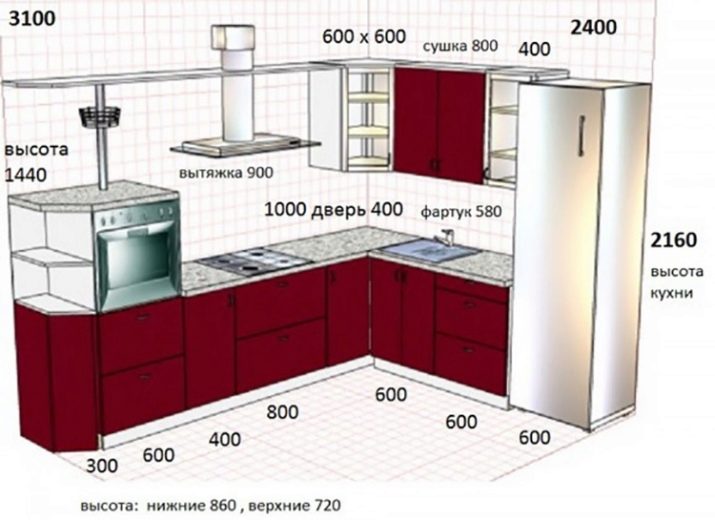
For how to quickly calculate the angular module of a kitchen set, see the next video.
